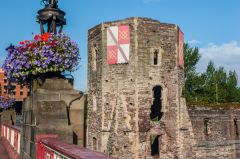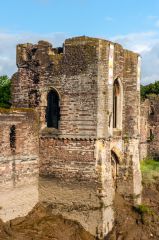
The new castle was erected by de Clare's brother in law, Hugh d'Audele, when Newport was made the centre for the new lordship of Wentloog. In 1405, at the time of the Glyndwr rebellion, Newport Castle was strengthened, and it was rebuilt once more between 1430-45 by Humphrey Stafford, later the 1st Duke of Buckingham.
The gradual decline of Newport Castle began with the execution for treason of the 3rd Duke in 1521. The castle was used into the 17th century, but gradually became a crumbling ruin, a picturesque, romantic subject for painters like JMW Turner.
The castle buildings were converted to use as a brewery in the 19th century, and the final indignity came in 1970 when a road was built across the western end of the castle site.
The 14th-century castle consisted of a rectangular walled court, surrounded by a moat. The imposing river frontage has three main towers; one at either end and one in the middle. While the end towers are polygonal, the centre tower is rectangular, with projecting turrets guarding a water gate.
In the tower are a series of luxurious (for the time) apartments. To the north is a great hall, the centre of castle life, while above the water gate is an audience chamber, and the kitchens lie to the south.
Note: Don't confuse this Newport Castle with the smaller medieval fortress at Newport, Pembrokeshire.





 We've 'tagged' this attraction information to help you find related historic attractions and learn more about major time periods mentioned.
We've 'tagged' this attraction information to help you find related historic attractions and learn more about major time periods mentioned.




